Institutional affiliation Research Paper 2022
VerifiedAdded on 2022/09/21
|6
|1437
|21
AI Summary
Contribute Materials
Your contribution can guide someone’s learning journey. Share your
documents today.
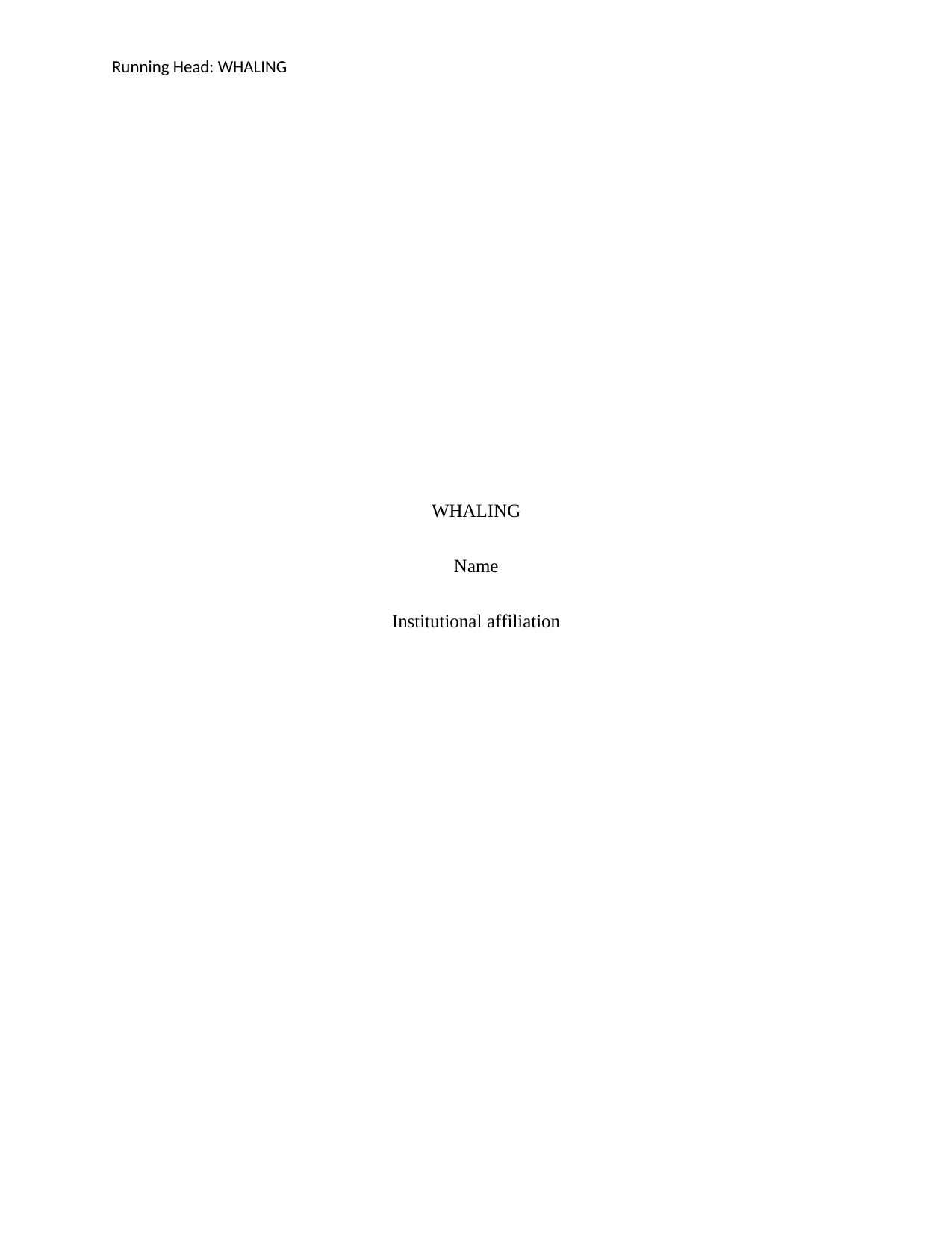
Running Head: WHALING
WHALING
Name
Institutional affiliation
WHALING
Name
Institutional affiliation
Secure Best Marks with AI Grader
Need help grading? Try our AI Grader for instant feedback on your assignments.
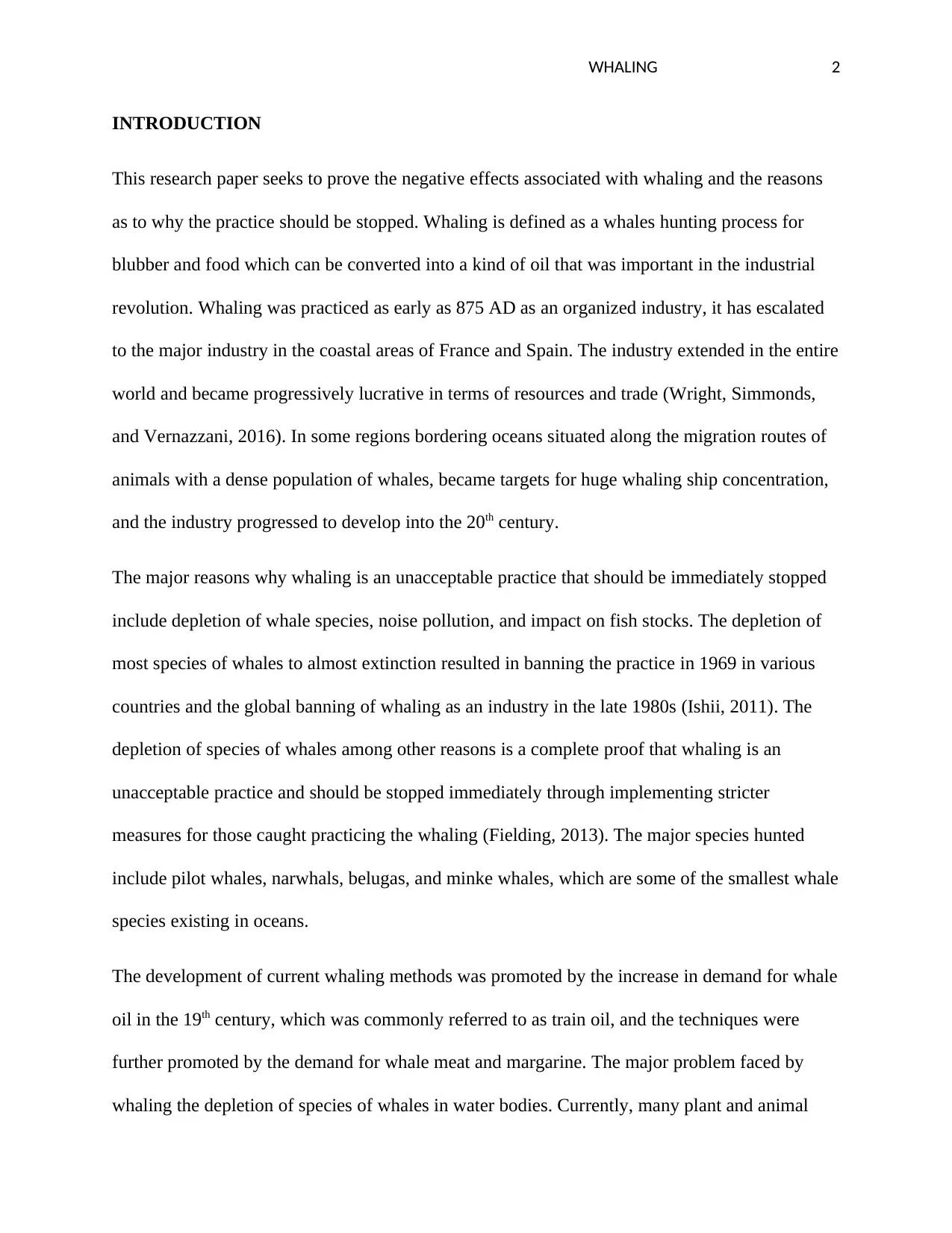
WHALING 2
INTRODUCTION
This research paper seeks to prove the negative effects associated with whaling and the reasons
as to why the practice should be stopped. Whaling is defined as a whales hunting process for
blubber and food which can be converted into a kind of oil that was important in the industrial
revolution. Whaling was practiced as early as 875 AD as an organized industry, it has escalated
to the major industry in the coastal areas of France and Spain. The industry extended in the entire
world and became progressively lucrative in terms of resources and trade (Wright, Simmonds,
and Vernazzani, 2016). In some regions bordering oceans situated along the migration routes of
animals with a dense population of whales, became targets for huge whaling ship concentration,
and the industry progressed to develop into the 20th century.
The major reasons why whaling is an unacceptable practice that should be immediately stopped
include depletion of whale species, noise pollution, and impact on fish stocks. The depletion of
most species of whales to almost extinction resulted in banning the practice in 1969 in various
countries and the global banning of whaling as an industry in the late 1980s (Ishii, 2011). The
depletion of species of whales among other reasons is a complete proof that whaling is an
unacceptable practice and should be stopped immediately through implementing stricter
measures for those caught practicing the whaling (Fielding, 2013). The major species hunted
include pilot whales, narwhals, belugas, and minke whales, which are some of the smallest whale
species existing in oceans.
The development of current whaling methods was promoted by the increase in demand for whale
oil in the 19th century, which was commonly referred to as train oil, and the techniques were
further promoted by the demand for whale meat and margarine. The major problem faced by
whaling the depletion of species of whales in water bodies. Currently, many plant and animal
INTRODUCTION
This research paper seeks to prove the negative effects associated with whaling and the reasons
as to why the practice should be stopped. Whaling is defined as a whales hunting process for
blubber and food which can be converted into a kind of oil that was important in the industrial
revolution. Whaling was practiced as early as 875 AD as an organized industry, it has escalated
to the major industry in the coastal areas of France and Spain. The industry extended in the entire
world and became progressively lucrative in terms of resources and trade (Wright, Simmonds,
and Vernazzani, 2016). In some regions bordering oceans situated along the migration routes of
animals with a dense population of whales, became targets for huge whaling ship concentration,
and the industry progressed to develop into the 20th century.
The major reasons why whaling is an unacceptable practice that should be immediately stopped
include depletion of whale species, noise pollution, and impact on fish stocks. The depletion of
most species of whales to almost extinction resulted in banning the practice in 1969 in various
countries and the global banning of whaling as an industry in the late 1980s (Ishii, 2011). The
depletion of species of whales among other reasons is a complete proof that whaling is an
unacceptable practice and should be stopped immediately through implementing stricter
measures for those caught practicing the whaling (Fielding, 2013). The major species hunted
include pilot whales, narwhals, belugas, and minke whales, which are some of the smallest whale
species existing in oceans.
The development of current whaling methods was promoted by the increase in demand for whale
oil in the 19th century, which was commonly referred to as train oil, and the techniques were
further promoted by the demand for whale meat and margarine. The major problem faced by
whaling the depletion of species of whales in water bodies. Currently, many plant and animal
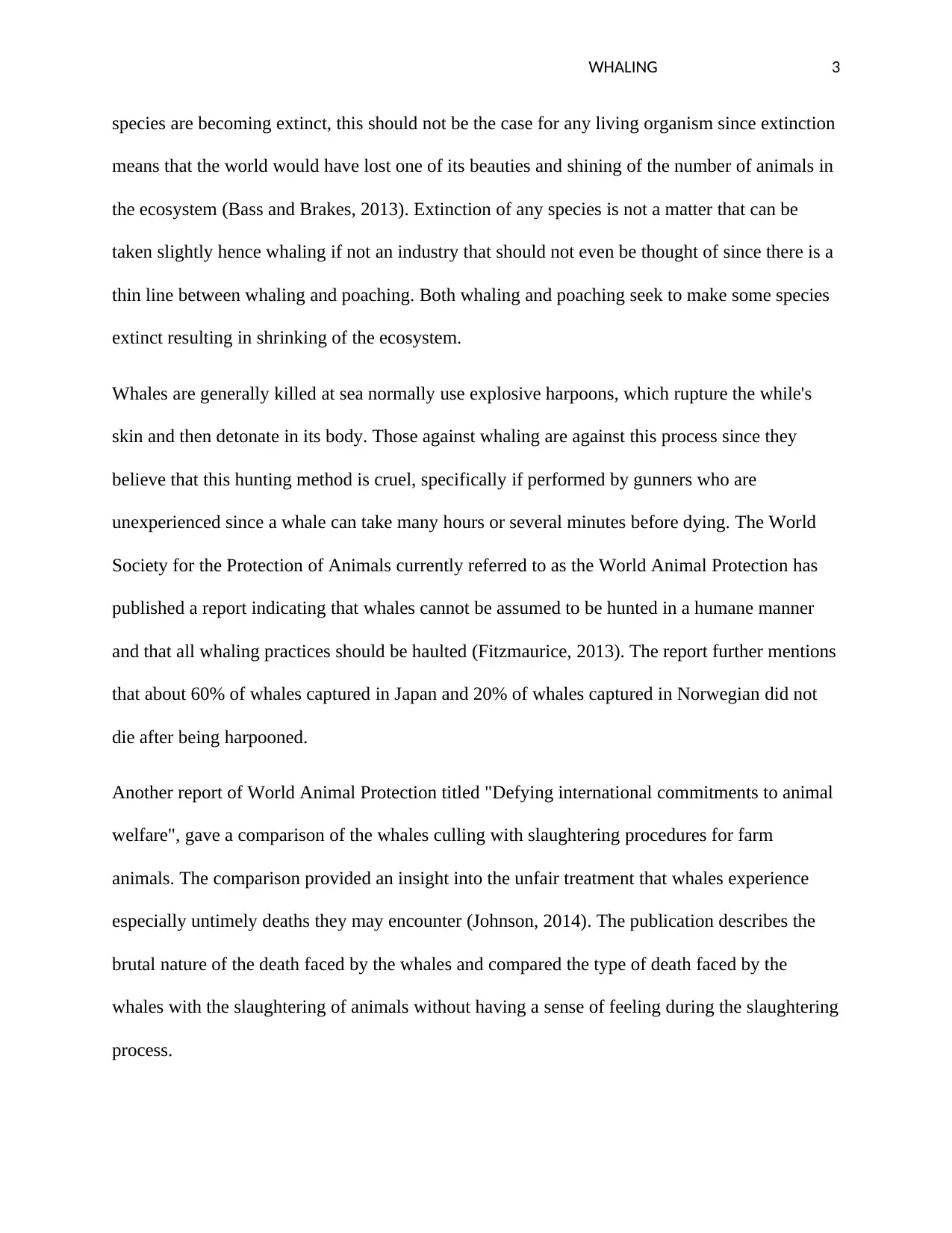
WHALING 3
species are becoming extinct, this should not be the case for any living organism since extinction
means that the world would have lost one of its beauties and shining of the number of animals in
the ecosystem (Bass and Brakes, 2013). Extinction of any species is not a matter that can be
taken slightly hence whaling if not an industry that should not even be thought of since there is a
thin line between whaling and poaching. Both whaling and poaching seek to make some species
extinct resulting in shrinking of the ecosystem.
Whales are generally killed at sea normally use explosive harpoons, which rupture the while's
skin and then detonate in its body. Those against whaling are against this process since they
believe that this hunting method is cruel, specifically if performed by gunners who are
unexperienced since a whale can take many hours or several minutes before dying. The World
Society for the Protection of Animals currently referred to as the World Animal Protection has
published a report indicating that whales cannot be assumed to be hunted in a humane manner
and that all whaling practices should be haulted (Fitzmaurice, 2013). The report further mentions
that about 60% of whales captured in Japan and 20% of whales captured in Norwegian did not
die after being harpooned.
Another report of World Animal Protection titled "Defying international commitments to animal
welfare", gave a comparison of the whales culling with slaughtering procedures for farm
animals. The comparison provided an insight into the unfair treatment that whales experience
especially untimely deaths they may encounter (Johnson, 2014). The publication describes the
brutal nature of the death faced by the whales and compared the type of death faced by the
whales with the slaughtering of animals without having a sense of feeling during the slaughtering
process.
species are becoming extinct, this should not be the case for any living organism since extinction
means that the world would have lost one of its beauties and shining of the number of animals in
the ecosystem (Bass and Brakes, 2013). Extinction of any species is not a matter that can be
taken slightly hence whaling if not an industry that should not even be thought of since there is a
thin line between whaling and poaching. Both whaling and poaching seek to make some species
extinct resulting in shrinking of the ecosystem.
Whales are generally killed at sea normally use explosive harpoons, which rupture the while's
skin and then detonate in its body. Those against whaling are against this process since they
believe that this hunting method is cruel, specifically if performed by gunners who are
unexperienced since a whale can take many hours or several minutes before dying. The World
Society for the Protection of Animals currently referred to as the World Animal Protection has
published a report indicating that whales cannot be assumed to be hunted in a humane manner
and that all whaling practices should be haulted (Fitzmaurice, 2013). The report further mentions
that about 60% of whales captured in Japan and 20% of whales captured in Norwegian did not
die after being harpooned.
Another report of World Animal Protection titled "Defying international commitments to animal
welfare", gave a comparison of the whales culling with slaughtering procedures for farm
animals. The comparison provided an insight into the unfair treatment that whales experience
especially untimely deaths they may encounter (Johnson, 2014). The publication describes the
brutal nature of the death faced by the whales and compared the type of death faced by the
whales with the slaughtering of animals without having a sense of feeling during the slaughtering
process.
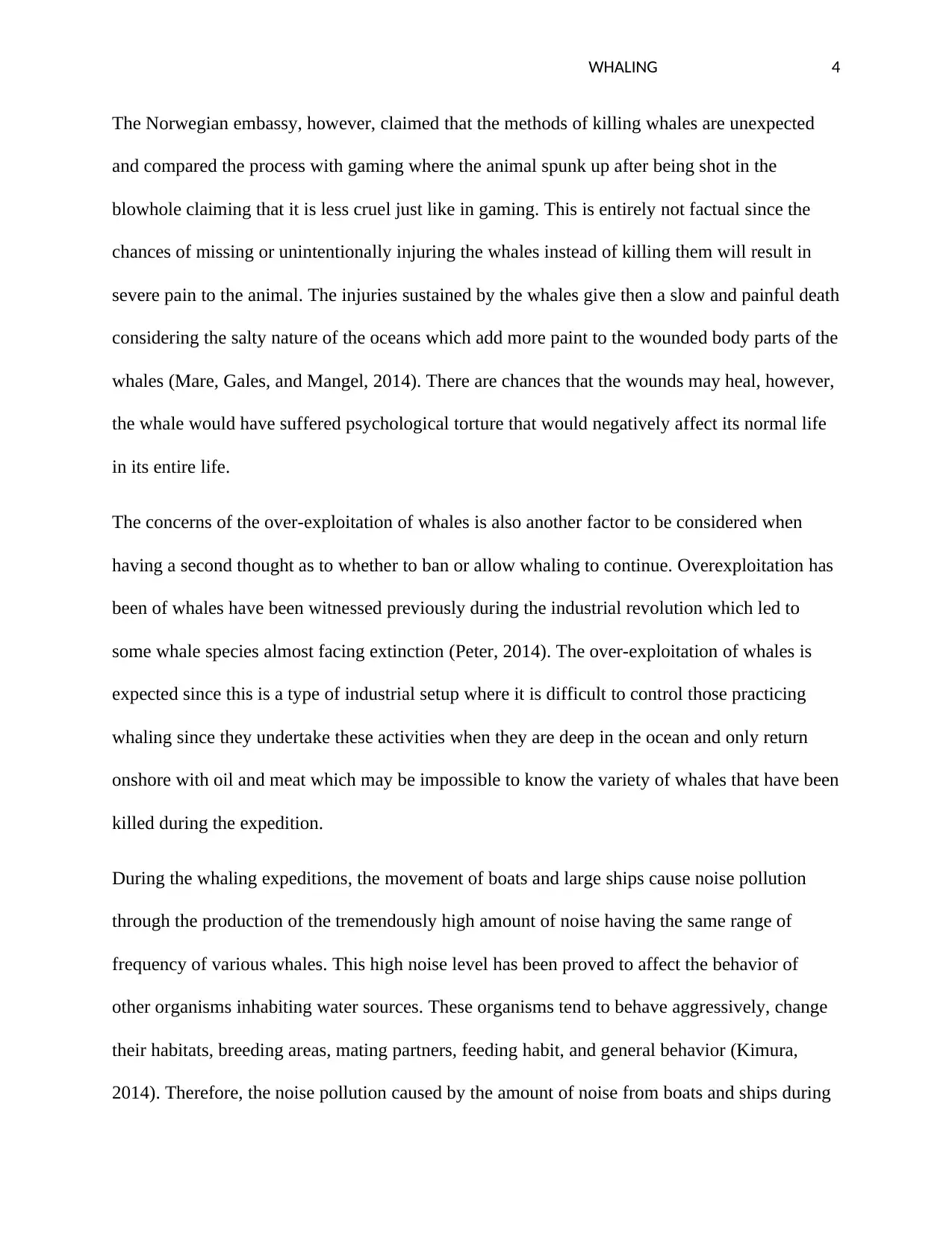
WHALING 4
The Norwegian embassy, however, claimed that the methods of killing whales are unexpected
and compared the process with gaming where the animal spunk up after being shot in the
blowhole claiming that it is less cruel just like in gaming. This is entirely not factual since the
chances of missing or unintentionally injuring the whales instead of killing them will result in
severe pain to the animal. The injuries sustained by the whales give then a slow and painful death
considering the salty nature of the oceans which add more paint to the wounded body parts of the
whales (Mare, Gales, and Mangel, 2014). There are chances that the wounds may heal, however,
the whale would have suffered psychological torture that would negatively affect its normal life
in its entire life.
The concerns of the over-exploitation of whales is also another factor to be considered when
having a second thought as to whether to ban or allow whaling to continue. Overexploitation has
been of whales have been witnessed previously during the industrial revolution which led to
some whale species almost facing extinction (Peter, 2014). The over-exploitation of whales is
expected since this is a type of industrial setup where it is difficult to control those practicing
whaling since they undertake these activities when they are deep in the ocean and only return
onshore with oil and meat which may be impossible to know the variety of whales that have been
killed during the expedition.
During the whaling expeditions, the movement of boats and large ships cause noise pollution
through the production of the tremendously high amount of noise having the same range of
frequency of various whales. This high noise level has been proved to affect the behavior of
other organisms inhabiting water sources. These organisms tend to behave aggressively, change
their habitats, breeding areas, mating partners, feeding habit, and general behavior (Kimura,
2014). Therefore, the noise pollution caused by the amount of noise from boats and ships during
The Norwegian embassy, however, claimed that the methods of killing whales are unexpected
and compared the process with gaming where the animal spunk up after being shot in the
blowhole claiming that it is less cruel just like in gaming. This is entirely not factual since the
chances of missing or unintentionally injuring the whales instead of killing them will result in
severe pain to the animal. The injuries sustained by the whales give then a slow and painful death
considering the salty nature of the oceans which add more paint to the wounded body parts of the
whales (Mare, Gales, and Mangel, 2014). There are chances that the wounds may heal, however,
the whale would have suffered psychological torture that would negatively affect its normal life
in its entire life.
The concerns of the over-exploitation of whales is also another factor to be considered when
having a second thought as to whether to ban or allow whaling to continue. Overexploitation has
been of whales have been witnessed previously during the industrial revolution which led to
some whale species almost facing extinction (Peter, 2014). The over-exploitation of whales is
expected since this is a type of industrial setup where it is difficult to control those practicing
whaling since they undertake these activities when they are deep in the ocean and only return
onshore with oil and meat which may be impossible to know the variety of whales that have been
killed during the expedition.
During the whaling expeditions, the movement of boats and large ships cause noise pollution
through the production of the tremendously high amount of noise having the same range of
frequency of various whales. This high noise level has been proved to affect the behavior of
other organisms inhabiting water sources. These organisms tend to behave aggressively, change
their habitats, breeding areas, mating partners, feeding habit, and general behavior (Kimura,
2014). Therefore, the noise pollution caused by the amount of noise from boats and ships during
Secure Best Marks with AI Grader
Need help grading? Try our AI Grader for instant feedback on your assignments.
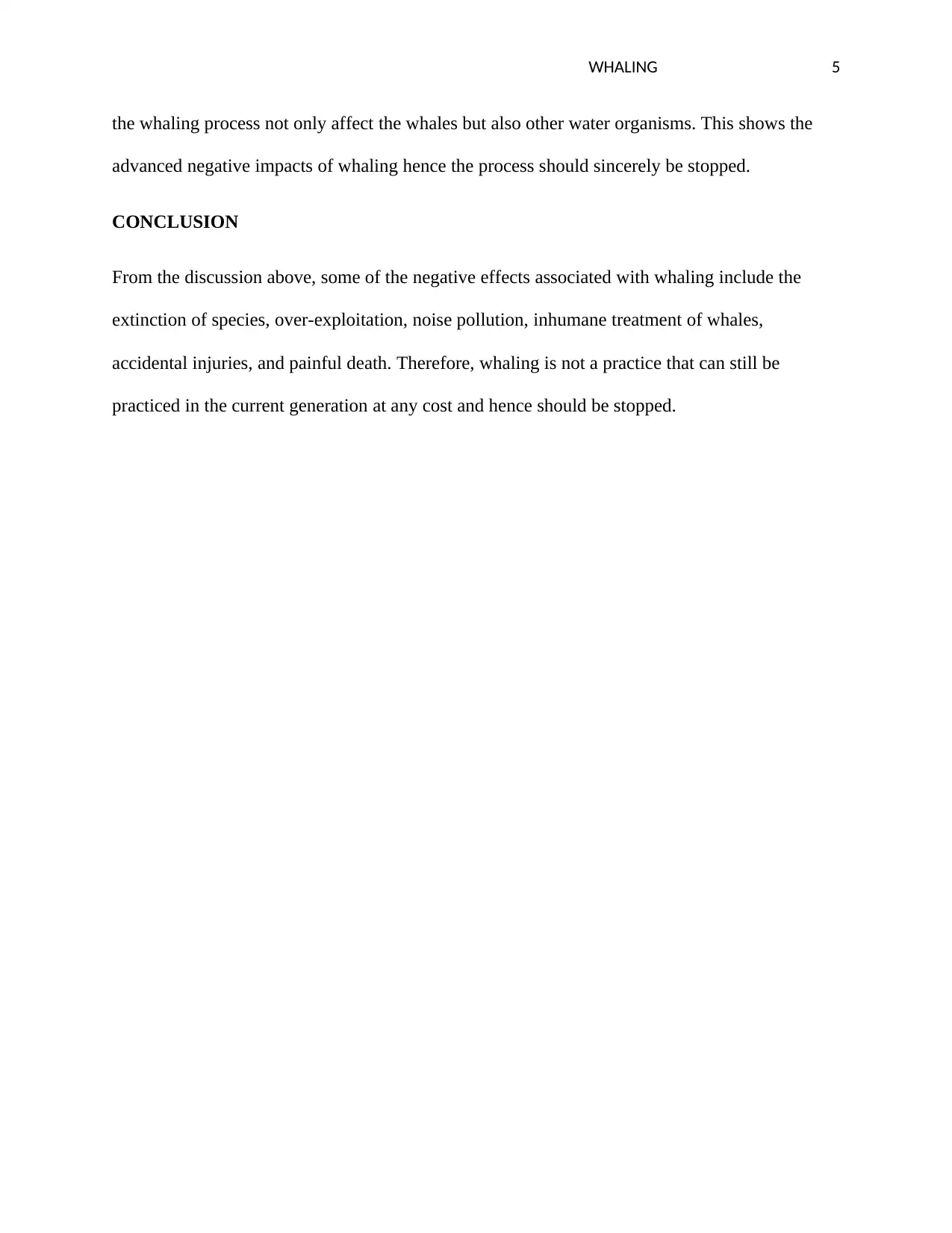
WHALING 5
the whaling process not only affect the whales but also other water organisms. This shows the
advanced negative impacts of whaling hence the process should sincerely be stopped.
CONCLUSION
From the discussion above, some of the negative effects associated with whaling include the
extinction of species, over-exploitation, noise pollution, inhumane treatment of whales,
accidental injuries, and painful death. Therefore, whaling is not a practice that can still be
practiced in the current generation at any cost and hence should be stopped.
the whaling process not only affect the whales but also other water organisms. This shows the
advanced negative impacts of whaling hence the process should sincerely be stopped.
CONCLUSION
From the discussion above, some of the negative effects associated with whaling include the
extinction of species, over-exploitation, noise pollution, inhumane treatment of whales,
accidental injuries, and painful death. Therefore, whaling is not a practice that can still be
practiced in the current generation at any cost and hence should be stopped.
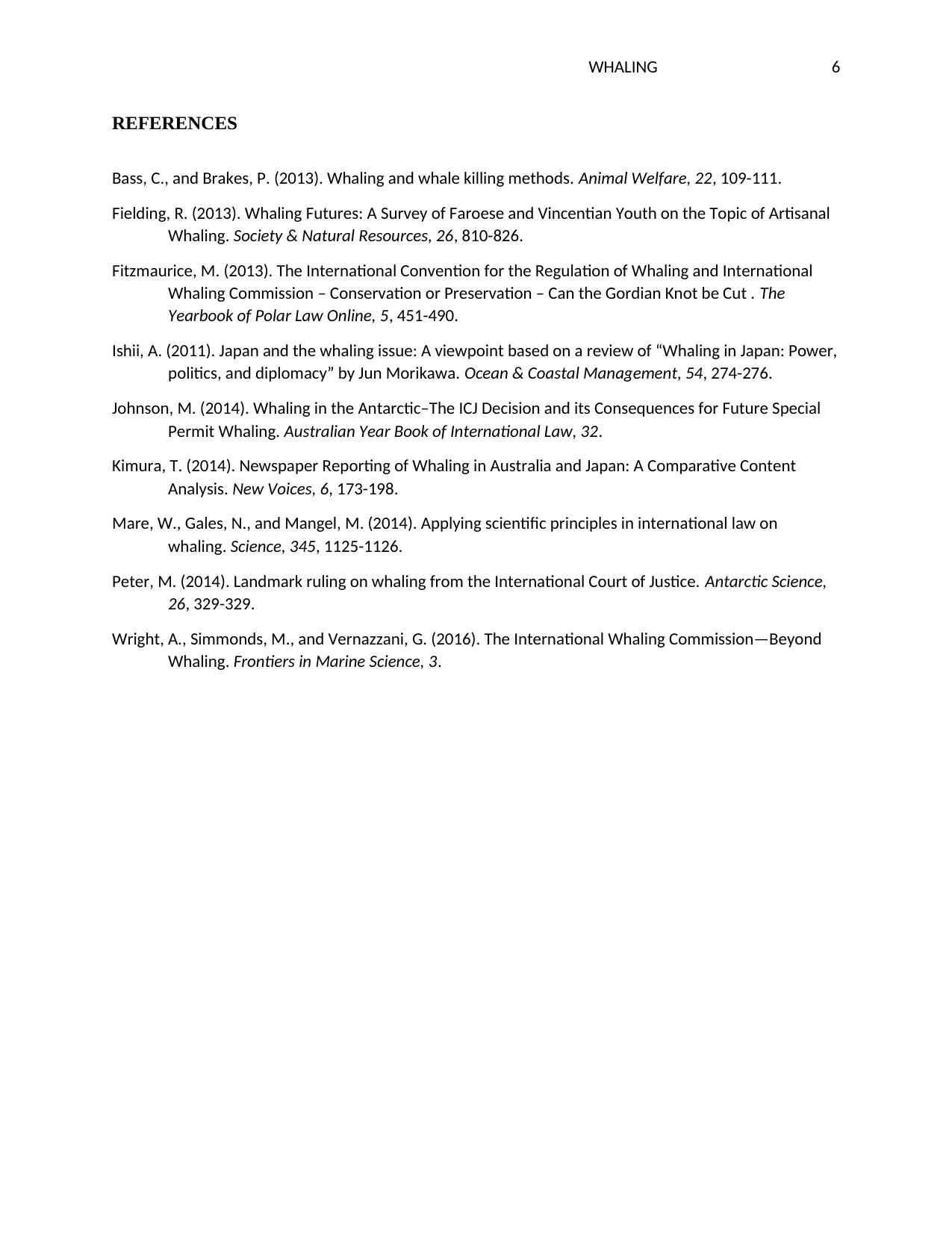
WHALING 6
REFERENCES
Bass, C., and Brakes, P. (2013). Whaling and whale killing methods. Animal Welfare, 22, 109-111.
Fielding, R. (2013). Whaling Futures: A Survey of Faroese and Vincentian Youth on the Topic of Artisanal
Whaling. Society & Natural Resources, 26, 810-826.
Fitzmaurice, M. (2013). The International Convention for the Regulation of Whaling and International
Whaling Commission – Conservation or Preservation – Can the Gordian Knot be Cut . The
Yearbook of Polar Law Online, 5, 451-490.
Ishii, A. (2011). Japan and the whaling issue: A viewpoint based on a review of “Whaling in Japan: Power,
politics, and diplomacy” by Jun Morikawa. Ocean & Coastal Management, 54, 274-276.
Johnson, M. (2014). Whaling in the Antarctic–The ICJ Decision and its Consequences for Future Special
Permit Whaling. Australian Year Book of International Law, 32.
Kimura, T. (2014). Newspaper Reporting of Whaling in Australia and Japan: A Comparative Content
Analysis. New Voices, 6, 173-198.
Mare, W., Gales, N., and Mangel, M. (2014). Applying scientific principles in international law on
whaling. Science, 345, 1125-1126.
Peter, M. (2014). Landmark ruling on whaling from the International Court of Justice. Antarctic Science,
26, 329-329.
Wright, A., Simmonds, M., and Vernazzani, G. (2016). The International Whaling Commission—Beyond
Whaling. Frontiers in Marine Science, 3.
REFERENCES
Bass, C., and Brakes, P. (2013). Whaling and whale killing methods. Animal Welfare, 22, 109-111.
Fielding, R. (2013). Whaling Futures: A Survey of Faroese and Vincentian Youth on the Topic of Artisanal
Whaling. Society & Natural Resources, 26, 810-826.
Fitzmaurice, M. (2013). The International Convention for the Regulation of Whaling and International
Whaling Commission – Conservation or Preservation – Can the Gordian Knot be Cut . The
Yearbook of Polar Law Online, 5, 451-490.
Ishii, A. (2011). Japan and the whaling issue: A viewpoint based on a review of “Whaling in Japan: Power,
politics, and diplomacy” by Jun Morikawa. Ocean & Coastal Management, 54, 274-276.
Johnson, M. (2014). Whaling in the Antarctic–The ICJ Decision and its Consequences for Future Special
Permit Whaling. Australian Year Book of International Law, 32.
Kimura, T. (2014). Newspaper Reporting of Whaling in Australia and Japan: A Comparative Content
Analysis. New Voices, 6, 173-198.
Mare, W., Gales, N., and Mangel, M. (2014). Applying scientific principles in international law on
whaling. Science, 345, 1125-1126.
Peter, M. (2014). Landmark ruling on whaling from the International Court of Justice. Antarctic Science,
26, 329-329.
Wright, A., Simmonds, M., and Vernazzani, G. (2016). The International Whaling Commission—Beyond
Whaling. Frontiers in Marine Science, 3.
1 out of 6
Your All-in-One AI-Powered Toolkit for Academic Success.
+13062052269
info@desklib.com
Available 24*7 on WhatsApp / Email
![[object Object]](/_next/static/media/star-bottom.7253800d.svg)
Unlock your academic potential
© 2024 | Zucol Services PVT LTD | All rights reserved.


